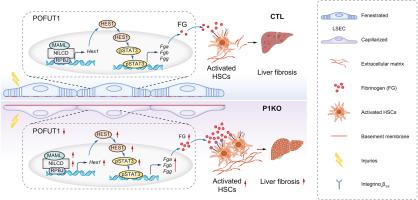当前位置:
X-MOL 学术
›
J. Hepatol.
›
论文详情
Our official English website, www.x-mol.net, welcomes your feedback! (Note: you will need to create a separate account there.)
Endothelial POFUT1 controls injury-induced liver fibrosis by repressing fibrinogen synthesis
Journal of Hepatology ( IF 25.7 ) Pub Date : 2024-03-07 , DOI: 10.1016/j.jhep.2024.02.032 Shan He , Yuru Luo , Wangge Ma , Xiaoke Wang , Chengrong Yan , Wenyang Hao , Yuan Fang , Hongyu Su , Baochang Lai , Junhui Liu , Ying Xiong , Ting Bai , Xiaoyong Ren , Enqi Liu , Hua Han , Yue Wu , Zuyi Yuan , Yidong Wang
Journal of Hepatology ( IF 25.7 ) Pub Date : 2024-03-07 , DOI: 10.1016/j.jhep.2024.02.032 Shan He , Yuru Luo , Wangge Ma , Xiaoke Wang , Chengrong Yan , Wenyang Hao , Yuan Fang , Hongyu Su , Baochang Lai , Junhui Liu , Ying Xiong , Ting Bai , Xiaoyong Ren , Enqi Liu , Hua Han , Yue Wu , Zuyi Yuan , Yidong Wang

|
NOTCH signaling in liver sinusoidal endothelial cells (LSECs) regulates liver fibrosis, a pathological feature of chronic liver diseases. POFUT1 is an essential regulator of NOTCH signaling. Here, we investigated the role of LSEC-expressed POFUT1 in liver fibrosis. Endothelial-specific knockout mice were generated and experimental liver fibrosis was induced by chronic carbon tetrachloride exposure or common bile duct ligation. Liver samples were assessed by ELISA, histology, electron microscopy, immunostaining and hybridization. LSECs and hepatic stellate cells (HSCs) were isolated for gene expression analysis by RNA sequencing, qPCR, and western blotting. Signaling crosstalk between LSECs and HSCs was investigated by treating HSCs with supernatant from LSEC cultures. Liver single-cell RNA sequencing datasets from patients with cirrhosis and healthy individuals were analyzed to evaluate the clinical relevance of gene expression changes observed in mouse studies. POFUT1 loss promoted injury-induced LSEC capillarization and HSC activation, leading to aggravated liver fibrosis. RNA sequencing analysis revealed that POFUT1 deficiency upregulated fibrinogen expression in LSECs. Consistently, fibrinogen was elevated in LSECs of patients with cirrhosis. HSCs treated with supernatant from LSECs of null mice showed exacerbated activation compared to those treated with supernatant from control LSECs, and this effect was attenuated by knockdown of fibrinogen or by pharmacological inhibition of fibrinogen receptor signaling, altogether suggesting that LSEC-derived fibrinogen induced the activation of HSCs. Mechanistically, POFUT1 loss augmented fibrinogen expression by enhancing NOTCH/HES1/STAT3 signaling. Endothelial POFUT1 prevents injury-induced liver fibrosis by repressing the expression of fibrinogen, which functions as a profibrotic paracrine signal to activate HSCs. Therapies targeting the POFUT1/fibrinogen axis offer a promising strategy for the prevention and treatment of fibrotic liver diseases. Paracrine signals produced by liver vasculature play a major role in the development of liver fibrosis, which is a pathological hallmark of most liver diseases. Identifying those paracrine signals is clinically relevant in that they may serve as therapeutic targets. In this study, we discovered that genetic deletion of aggravated experimental liver fibrosis in mouse models. Moreover, fibrinogen was identified as a downstream target repressed by in liver endothelial cells and functioned as a novel paracrine signal that drove liver fibrosis. In addition, fibrinogen was found to be relevant to cirrhosis and may serve as a potential therapeutic target for this devastating human disease.
中文翻译:

内皮 POFUT1 通过抑制纤维蛋白原合成来控制损伤诱导的肝纤维化
肝窦内皮细胞 (LSEC) 中的 NOTCH 信号传导可调节肝纤维化,这是慢性肝病的病理特征。 POFUT1 是 NOTCH 信号传导的重要调节因子。在这里,我们研究了 LSEC 表达的 POFUT1 在肝纤维化中的作用。生成内皮特异性基因敲除小鼠,并通过慢性四氯化碳暴露或胆总管结扎诱导实验性肝纤维化。通过 ELISA、组织学、电子显微镜、免疫染色和杂交对肝脏样本进行评估。分离 LSEC 和肝星状细胞 (HSC),通过 RNA 测序、qPCR 和蛋白质印迹进行基因表达分析。通过用 LSEC 培养物上清液处理 HSC 来研究 LSEC 和 HSC 之间的信号串扰。分析了肝硬化患者和健康个体的肝脏单细胞 RNA 测序数据集,以评估小鼠研究中观察到的基因表达变化的临床相关性。 POFUT1缺失促进了损伤引起的LSEC毛细血管化和HSC活化,导致肝纤维化加剧。 RNA测序分析显示,POFUT1缺陷上调了LSEC中纤维蛋白原的表达。一致地,肝硬化患者的 LSEC 中纤维蛋白原升高。与用对照 LSEC 上清液处理的 HSC 相比,用无效小鼠 LSEC 上清液处理的 HSC 表现出更严重的激活,并且这种效应通过纤维蛋白原的敲低或纤维蛋白原受体信号传导的药理抑制而减弱,这共同表明 LSEC 衍生的纤维蛋白原诱导了激活HSC 的数量。从机制上讲,POFUT1 缺失通过增强 NOTCH/HES1/STAT3 信号传导来增强纤维蛋白原表达。内皮 POFUT1 通过抑制纤维蛋白原的表达来预防损伤诱导的肝纤维化,纤维蛋白原作为促纤维化旁分泌信号来激活 HSC。针对 POFUT1/纤维蛋白原轴的治疗为预防和治疗纤维化肝病提供了一种有前景的策略。肝脏血管系统产生的旁分泌信号在肝纤维化的发展中起重要作用,肝纤维化是大多数肝脏疾病的病理标志。识别这些旁分泌信号具有临床意义,因为它们可以作为治疗靶点。在这项研究中,我们发现基因缺失会加剧小鼠模型中的实验性肝纤维化。此外,纤维蛋白原被确定为肝内皮细胞抑制的下游靶标,并作为驱动肝纤维化的新型旁分泌信号。此外,纤维蛋白原被发现与肝硬化有关,并可能作为这种毁灭性人类疾病的潜在治疗靶点。
更新日期:2024-03-07
中文翻译:

内皮 POFUT1 通过抑制纤维蛋白原合成来控制损伤诱导的肝纤维化
肝窦内皮细胞 (LSEC) 中的 NOTCH 信号传导可调节肝纤维化,这是慢性肝病的病理特征。 POFUT1 是 NOTCH 信号传导的重要调节因子。在这里,我们研究了 LSEC 表达的 POFUT1 在肝纤维化中的作用。生成内皮特异性基因敲除小鼠,并通过慢性四氯化碳暴露或胆总管结扎诱导实验性肝纤维化。通过 ELISA、组织学、电子显微镜、免疫染色和杂交对肝脏样本进行评估。分离 LSEC 和肝星状细胞 (HSC),通过 RNA 测序、qPCR 和蛋白质印迹进行基因表达分析。通过用 LSEC 培养物上清液处理 HSC 来研究 LSEC 和 HSC 之间的信号串扰。分析了肝硬化患者和健康个体的肝脏单细胞 RNA 测序数据集,以评估小鼠研究中观察到的基因表达变化的临床相关性。 POFUT1缺失促进了损伤引起的LSEC毛细血管化和HSC活化,导致肝纤维化加剧。 RNA测序分析显示,POFUT1缺陷上调了LSEC中纤维蛋白原的表达。一致地,肝硬化患者的 LSEC 中纤维蛋白原升高。与用对照 LSEC 上清液处理的 HSC 相比,用无效小鼠 LSEC 上清液处理的 HSC 表现出更严重的激活,并且这种效应通过纤维蛋白原的敲低或纤维蛋白原受体信号传导的药理抑制而减弱,这共同表明 LSEC 衍生的纤维蛋白原诱导了激活HSC 的数量。从机制上讲,POFUT1 缺失通过增强 NOTCH/HES1/STAT3 信号传导来增强纤维蛋白原表达。内皮 POFUT1 通过抑制纤维蛋白原的表达来预防损伤诱导的肝纤维化,纤维蛋白原作为促纤维化旁分泌信号来激活 HSC。针对 POFUT1/纤维蛋白原轴的治疗为预防和治疗纤维化肝病提供了一种有前景的策略。肝脏血管系统产生的旁分泌信号在肝纤维化的发展中起重要作用,肝纤维化是大多数肝脏疾病的病理标志。识别这些旁分泌信号具有临床意义,因为它们可以作为治疗靶点。在这项研究中,我们发现基因缺失会加剧小鼠模型中的实验性肝纤维化。此外,纤维蛋白原被确定为肝内皮细胞抑制的下游靶标,并作为驱动肝纤维化的新型旁分泌信号。此外,纤维蛋白原被发现与肝硬化有关,并可能作为这种毁灭性人类疾病的潜在治疗靶点。



























 京公网安备 11010802027423号
京公网安备 11010802027423号